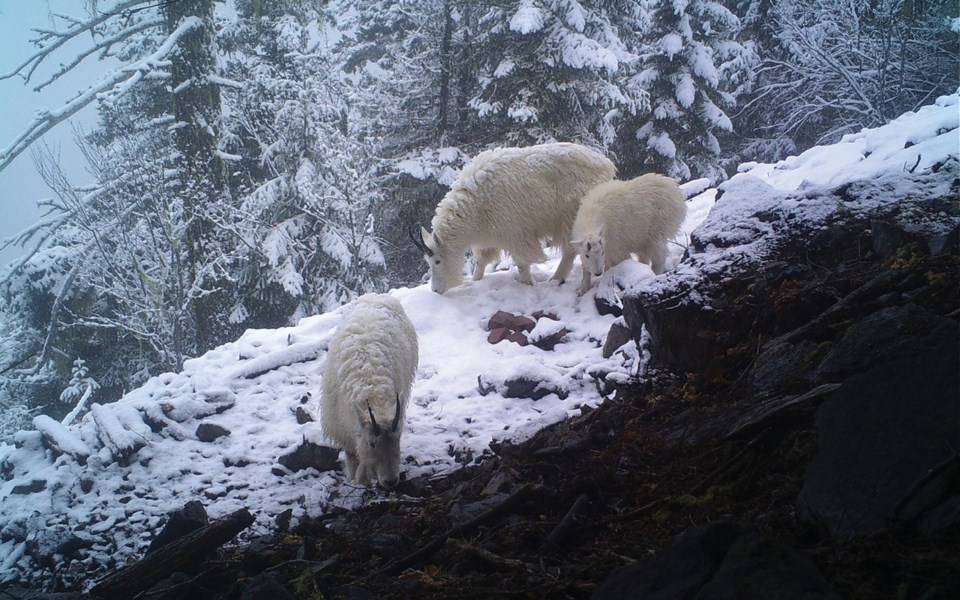At home in rugged mountain terrain, B.C. boasts more than half of the world's mountain goat populations.
In Cathedral Provincial Park, located southwest of Keremeos along the Canada-U.S. border, the animals are increasingly coming into conflict with humans over something found on most kitchen tables: salt.
"It's a very strong driver for goats," said Kirk Safford, a conservation specialist with BC Parks. "The alpine vegetation lacks many micronutrients and salt is one of them."
In recent years, goats have travelled down a steep ridge in order to visit the backcountry campground of Quiniscoe Lake, located in the park.
The campground has become a reliable mineral lick for the animals.
Campers' sweaty clothing, urine (the stuff that doesn't make it into outhouses), and grey water are proving to be a strong attractants for the animals, which are much more at home (and safer) on steep mountainsides, where the risk of predation is lower.
The human attractant is leading to some concerning behaviour in the goats, as the animals can "exert social dominance" over each other around salty sites, explained Safford.
Moreover, when you add people to the mix, the animals can become habituated to humans and start exerting dominance over them.
"That doesn't necessarily lead to someone getting hurt, but that's not something we want to experiment with, for lack of a better term," said Safford.
So far, there have not been any reported incidents of goats being aggressive towards people in Cathedral Park, but some have exerted their dominance by refusing to move off trails.
Scientists are therefore looking to learn more about the goats' behaviour.
Working with technicians from the Lower Similkameen Indian Band, they recently captured and collared 10 goats in late June and early July.
The collars, which will last three to four years, send out a GPS signal every six hours so researchers can record where the goats are wandering.
The goal is to learn more about the animals' habitat use and identify their winter range. This information can in turn be used to address management issues in the park.
Like a lot of human wildlife conflict, Safford said many of the problems stem from human behaviour, and the solution will lie in better education.
"The real solution is to remove the attractant, and that means park users need to properly dispose of their waste, whether it be grey water or urine," he said.
"If we can remove the attractants, the goats will find it less interesting. They will come by, but there will be less of a strong drive to be there."
Locally, Pemberton Wildlife Association (PWAS) President Allen McEwan said that most of the region's goat populations are relatively stable, though there is a decrease in the population in the Soo-Rutherford area.
In 2014, members of the PWA got involved in a provincial monitoring project for the Mount Pauline herd in the Upper Lillooet area, levelling out an area and making a salt lick that was used to attract goats.
Members captured and collared one goat in 2015 and one in 2016.
The goal of the project, said McEwan, was to gain a better understanding of the migration route of the animals from their winter to summer ranges, and where the animals spend the "really brutal" part of the winter.
GPS collars provided a wealth of important information to scientists, said McEwan.
"We know exactly where the migration trail is and we know what they do in the winter and summer," he said.
That said, the PWA chose not to continue on with the collaring work out of concern for the well being of the goats.
"It's very traumatic for the goats to be captured like that," he said. "We were concerned about the goats' health and survival."
Moreover, the project also presented a hazard to PWA volunteers.
"It's an extremely steep and dangerous place to work for our volunteers," said McEwan. "So we decided that it's in the best interest of both parties not to do any more tracking."
McEwan said he doesn't know of any issues locally that mirror what's going with Cathedral Provincial Park.
And he assumes that owes to the fact that there are likely natural salt licks in the area—so goats aren't drawn to human sources of it.
Yet despite decades of exploring the region, he's seen few of them over the years.
"I'm personally not aware of many of those sites," he said. "They must be something that just the animals know about."




